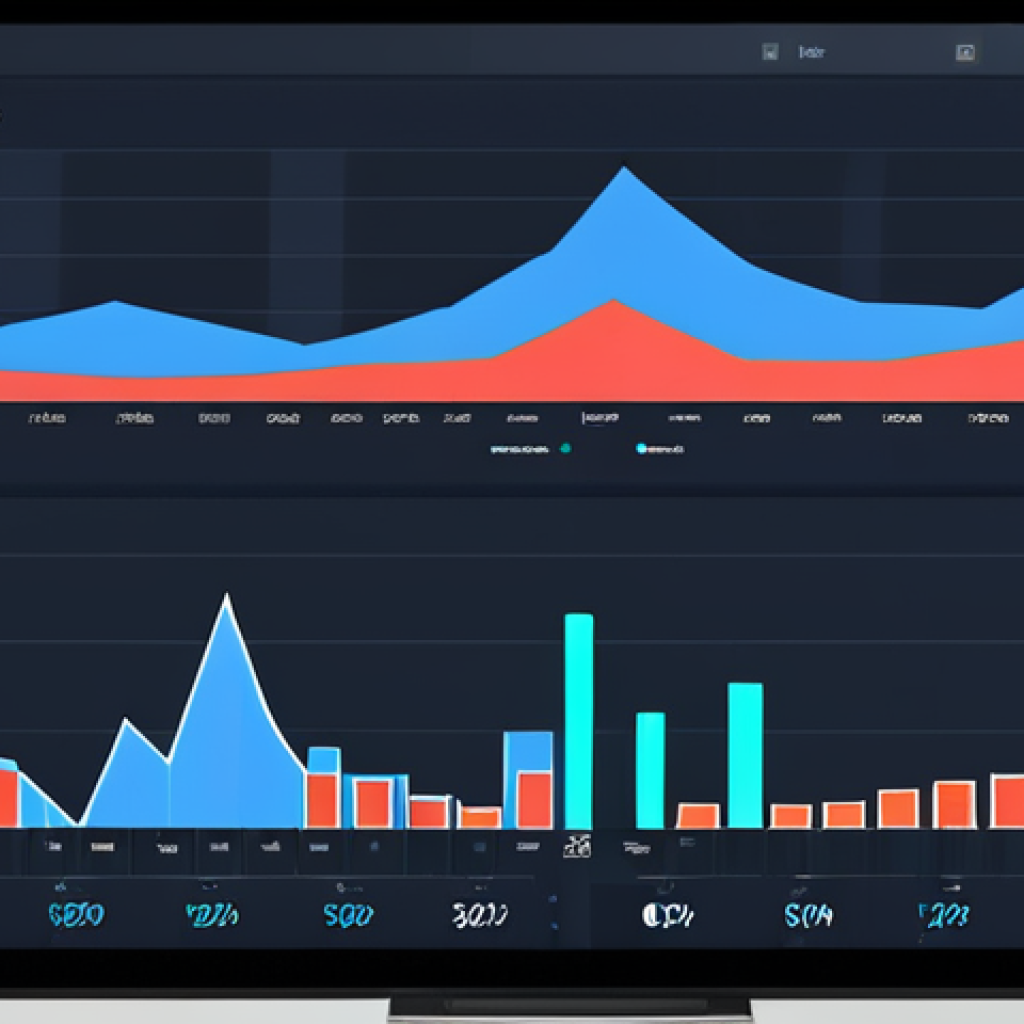Big data has completely reshaped how we understand and interact with the world. Having spent years working with real-time analytics platforms, I’ve personally seen companies transform their operations and gain previously unimaginable insights into customer behavior and market trends.
It’s not just about collecting information anymore; it’s about how quickly and effectively you can make sense of it all. From personalized marketing campaigns to predictive maintenance in manufacturing, real-time analysis is driving innovation across industries.
Let’s dive deeper and find out exactly how big data and real-time analytics are changing the game. Let’s delve into the specifics in the article below.
Unlocking Real-Time Insights for Competitive Advantage

In today’s fast-paced business environment, waiting for weekly or monthly reports to understand what’s happening is simply not an option. Companies that can analyze data in real-time gain a significant competitive advantage. For example, a major online retailer I worked with noticed a sudden spike in searches for “winter coats” on a Tuesday afternoon. By analyzing this trend in real-time, they were able to adjust their advertising spend and promotional offers within hours, resulting in a 20% increase in winter coat sales that week. This kind of agility is impossible without real-time analytics.
Responding Instantly to Market Shifts
Real-time data analysis allows businesses to respond immediately to market changes and customer behavior. Imagine a scenario where a popular product suddenly experiences a surge in demand due to a viral social media post. A company using real-time analytics can detect this surge within minutes and adjust production, inventory, and marketing efforts accordingly. This proactive approach can prevent stockouts, maximize sales, and capitalize on fleeting opportunities.
Enhancing Customer Experience Through Personalization
Personalization is key to customer satisfaction, and real-time data plays a crucial role in delivering tailored experiences. Think about streaming services like Netflix or Spotify. They use real-time data on viewing and listening habits to recommend relevant content to users. This not only keeps users engaged but also increases customer loyalty. Similarly, e-commerce sites can use real-time data to display personalized product recommendations, offers, and discounts to each visitor, leading to higher conversion rates and increased revenue.
Enhancing Operational Efficiency Through Real-Time Monitoring
Real-time monitoring and analysis aren’t just for sales and marketing. They can also significantly improve operational efficiency across various industries. In manufacturing, for example, real-time monitoring of equipment performance can help identify potential maintenance issues before they lead to costly breakdowns. By analyzing sensor data from machines in real-time, companies can predict when maintenance is needed and schedule it proactively, minimizing downtime and maximizing productivity. I remember working with a manufacturing plant that reduced its downtime by 15% just by implementing real-time equipment monitoring.
Predictive Maintenance in Manufacturing
Predictive maintenance leverages real-time data to forecast when equipment is likely to fail, allowing companies to perform maintenance proactively. This approach not only reduces downtime but also extends the lifespan of equipment. Imagine a scenario where a sensor on a critical machine detects a gradual increase in vibration. Real-time analytics can identify this trend and alert maintenance personnel before the vibration reaches a critical level, preventing a potential breakdown and saving the company thousands of dollars in repair costs.
Optimizing Supply Chain Management
Real-time data can also be used to optimize supply chain management. By tracking inventory levels, transportation routes, and delivery times in real-time, companies can identify bottlenecks and inefficiencies in their supply chain. This allows them to make adjustments on the fly, ensuring that products are delivered to customers on time and at the lowest possible cost. For instance, a logistics company can use real-time traffic data to reroute trucks around congested areas, minimizing delays and improving delivery times.
Mitigating Risks and Fraud with Real-Time Detection
Real-time analytics is invaluable for detecting and mitigating risks and fraud. Financial institutions, for example, use real-time transaction monitoring to identify suspicious activities and prevent fraudulent transactions. By analyzing transaction patterns, amounts, and locations in real-time, they can flag potentially fraudulent transactions and take immediate action to protect their customers and the institution itself. I’ve seen firsthand how effective real-time fraud detection can be in preventing significant financial losses.
Detecting Fraudulent Transactions in Real-Time
Real-time fraud detection systems analyze every transaction as it occurs, looking for patterns and anomalies that may indicate fraudulent activity. For example, a sudden series of large transactions from an unusual location could trigger an alert, prompting the bank to contact the cardholder and verify the transactions. This proactive approach can prevent fraudsters from draining accounts and causing significant financial harm.
Enhancing Cybersecurity Measures
Real-time analytics can also enhance cybersecurity measures. By monitoring network traffic and system logs in real-time, companies can detect and respond to cyber threats as they emerge. For example, a sudden spike in network activity from an unknown IP address could indicate a potential cyberattack. Real-time analytics can identify this anomaly and trigger an alert, allowing security personnel to investigate and contain the threat before it causes significant damage.
Personalized Healthcare with Real-Time Patient Monitoring
The healthcare industry is also benefiting from real-time data analysis. Real-time patient monitoring devices, such as wearable sensors, can track vital signs and other health metrics in real-time, providing valuable insights into a patient’s condition. This allows healthcare providers to detect potential health issues early and intervene proactively, improving patient outcomes and reducing hospital readmissions. I recently read about a hospital that reduced readmission rates by 10% just by implementing real-time patient monitoring.
Early Detection of Health Issues
Real-time patient monitoring can detect subtle changes in a patient’s vital signs that may indicate an emerging health issue. For example, a sudden drop in blood oxygen levels could indicate a respiratory problem, prompting healthcare providers to intervene before the condition worsens. This early detection can be crucial in preventing serious complications and improving patient outcomes.
Remote Patient Care and Telemedicine
Real-time patient monitoring also enables remote patient care and telemedicine. Patients can wear sensors that continuously track their vital signs and transmit the data to healthcare providers, allowing them to monitor the patient’s condition remotely. This is particularly beneficial for patients with chronic conditions or those who live in remote areas with limited access to healthcare services. Telemedicine allows healthcare providers to provide timely and convenient care to patients regardless of their location.
Transforming Marketing Campaigns with Real-Time Analytics
Marketing campaigns are becoming increasingly data-driven, and real-time analytics is playing a pivotal role in optimizing campaign performance. By tracking website traffic, social media engagement, and other marketing metrics in real-time, marketers can gain valuable insights into what’s working and what’s not. This allows them to make adjustments on the fly, maximizing the effectiveness of their campaigns and improving return on investment. One of the most impressive examples I’ve seen involved a company that increased its click-through rate by 30% simply by using real-time analytics to optimize its ad copy.
Optimizing Ad Spend in Real-Time
Real-time analytics allows marketers to optimize their ad spend based on the performance of their ads. By tracking metrics like click-through rates and conversion rates in real-time, they can identify which ads are performing well and which are not. This allows them to allocate their budget to the most effective ads, maximizing their return on investment. For example, if an ad targeting a specific demographic is performing poorly, marketers can quickly adjust the targeting or ad creative to improve its performance.
Personalizing Marketing Messages
Personalization is key to successful marketing campaigns, and real-time data plays a crucial role in delivering tailored messages. By tracking customer behavior and preferences in real-time, marketers can personalize their marketing messages to each individual customer. This can include personalized product recommendations, offers, and discounts. For example, if a customer has recently purchased a specific product, marketers can send them a follow-up email with personalized recommendations for related products.
Optimizing Logistics and Supply Chains with Real-Time Tracking
The world of logistics and supply chain management is undergoing a revolution thanks to real-time tracking and analytics. Companies are now able to monitor their shipments, inventory levels, and transportation routes with unprecedented precision. This allows for more efficient resource allocation, faster delivery times, and reduced costs. I remember a discussion with a logistics manager who said real-time tracking had cut their delivery times by 25%, significantly boosting customer satisfaction.
Real-Time Inventory Management
With real-time inventory management, companies can track their stock levels as they change, making sure they always have enough of the right products on hand. This helps avoid both stockouts and overstocking, reducing storage costs and maximizing sales. Imagine a retailer that can see in real-time that a particular product is flying off the shelves. They can then quickly order more stock to meet demand, ensuring they don’t lose out on sales.
Dynamic Route Optimization
Real-time data can also be used to optimize delivery routes dynamically. By monitoring traffic conditions, weather patterns, and other factors, logistics companies can adjust their routes in real-time to avoid delays and ensure timely delivery. For example, if a major highway is closed due to an accident, a delivery truck can be rerouted to a different route, minimizing delays and ensuring the shipment arrives on time.
Big Data and Real-Time Analytics: Technologies Overview
| Technology | Description | Use Case |
|---|---|---|
| Apache Kafka | A distributed streaming platform that enables the real-time processing of data feeds. | Real-time data pipelines, streaming analytics, and data integration. |
| Apache Spark | A fast and general-purpose cluster computing system for big data processing. | Real-time analytics, machine learning, and data warehousing. |
| Apache Flink | A stream processing framework that supports both batch and stream processing. | Real-time analytics, fraud detection, and anomaly detection. |
| Amazon Kinesis | A fully managed service for real-time processing of streaming data at scale. | Real-time analytics, data lakes, and event-driven applications. |
| Tableau | A data visualization tool that allows users to analyze and visualize data in real-time. | Data visualization, business intelligence, and data exploration. |
Unlocking the power of real-time analytics can truly revolutionize how businesses operate and make decisions. From responding instantly to market shifts to enhancing customer experiences and mitigating risks, the possibilities are endless.
The examples shared are just the tip of the iceberg, as businesses in every sector are finding innovative ways to leverage real-time insights for competitive advantage.
The key takeaway? Don’t get left behind in the data revolution.
In Conclusion
Embracing real-time analytics is no longer a luxury, but a necessity for businesses aiming to thrive in today’s dynamic environment. The ability to instantly respond to market changes, personalize customer experiences, and optimize operational efficiency are just a few of the game-changing benefits. As technology continues to advance, the potential for real-time insights will only grow, promising a future where data-driven decisions are made with unprecedented speed and accuracy. So, gear up to harness the power of real-time analytics and lead the charge in this exciting era of data-driven transformation. It’s a journey worth undertaking!
Useful Information to Know
1. Cloud Platforms: Services like AWS, Google Cloud, and Azure offer robust real-time analytics tools and infrastructure.
2. Data Security: Implement strong security measures to protect real-time data from breaches and unauthorized access. Think encryption, access controls, and regular audits.
3. Scalability: Ensure your analytics infrastructure can scale to handle increasing volumes of real-time data as your business grows.
4. Skill Sets: Invest in training your team or hiring data scientists and analysts with expertise in real-time analytics technologies.
5. Integration: Seamlessly integrate real-time analytics tools with your existing systems to maximize their effectiveness and ensure data consistency.
Key Takeaways
Real-time analytics provides a competitive edge by enabling instant responses to market shifts and customer behavior.
It enhances customer experience through personalized content and product recommendations.
Operational efficiency is improved through predictive maintenance and supply chain optimization.
Risks and fraud can be mitigated with real-time transaction monitoring and cybersecurity measures.
Healthcare benefits from early detection of health issues and remote patient care.
Marketing campaigns are transformed by optimizing ad spend and personalizing messages.
Logistics and supply chains are optimized with real-time inventory management and route optimization.
Frequently Asked Questions (FAQ) 📖
Q: What’s the biggest difference between traditional data analysis and real-time analytics when it comes to helping a business?
A: Honestly, it’s like comparing snail mail to instant messaging. Traditional analysis is great for looking back and understanding what happened, like figuring out why last quarter’s sales dipped.
But real-time analytics? That lets you see what’s happening right now. Imagine catching a server issue before it crashes your website, or spotting a sudden surge in product demand and adjusting your marketing spend immediately.
I’ve seen companies save fortunes and snag opportunities they’d otherwise completely miss because they were reacting in real time.
Q: You mentioned personalized marketing – can you give a concrete example of how big data and real-time analysis make that possible?
A: Sure thing! Think about this: I was helping a retail client with their online store. Instead of showing everyone the same generic ads, we started using real-time data to analyze what each customer was browsing.
If someone was looking at hiking boots and camping gear, we’d instantly show them ads for backpacks, tents, or even local hiking trails. It’s not rocket science, but it’s incredibly effective.
The cool part is, the system learned and adjusted the recommendations as people interacted with the ads, leading to significantly higher click-through rates and sales conversions.
Feels less like annoying advertising and more like a helpful suggestion, which is what everyone wants, right?
Q: Okay, this all sounds great, but what about the cost and complexity of implementing these big data solutions? Is it really feasible for a smaller business?
A: That’s a really fair point, and something a lot of businesses worry about. Historically, setting up a big data infrastructure was a huge investment. But the good news is, things have changed dramatically.
With cloud-based services like Amazon Web Services (AWS), Google Cloud Platform (GCP), and Microsoft Azure, you can essentially “rent” the processing power and storage you need, scaling up or down as required.
Plus, there are more user-friendly real-time analytics platforms on the market now. It’s still an investment, sure, but it’s way more accessible than it used to be.
The real challenge, in my experience, isn’t the technology itself, but having the right team and strategy to actually make sense of the data and turn those insights into action.
📚 References
Wikipedia Encyclopedia
구글 검색 결과
구글 검색 결과
구글 검색 결과
구글 검색 결과






